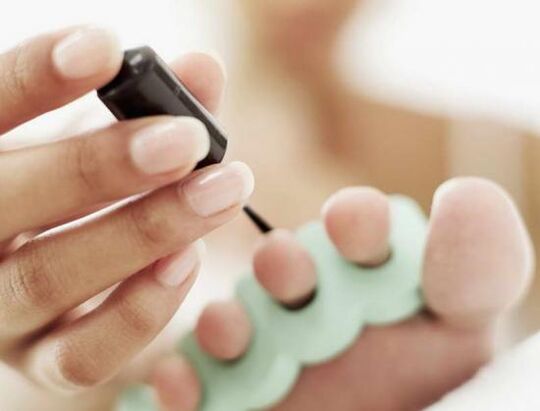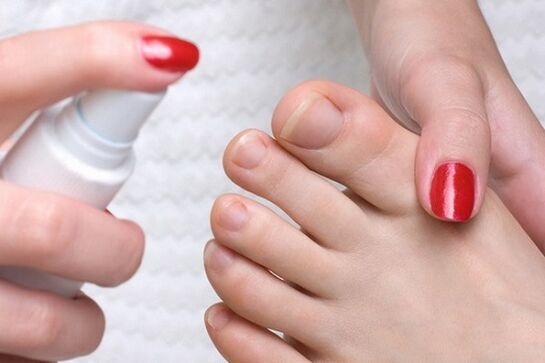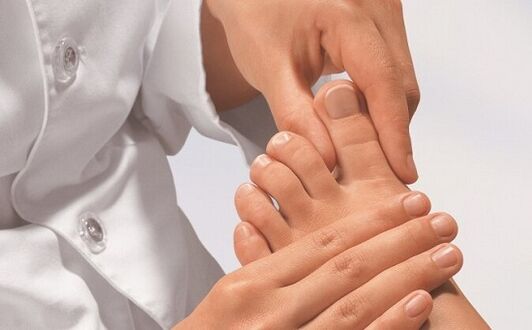
Nail fungus (lat. Onychomycosis) - in other words - an infection of the nails on the nails. The disease can affect fingernails and toenails. The reason is what is called a dermatophyte, more rarely a fungus of the Candida species (yeast) or fungus.
Discoloration, thickened and brittle nails are symptoms of fungus, but also other skin and nail diseases, therefore, if there are such changes, it is necessary to contact a dermatologist and perform bacteriological tests for the presence of fungus. like sowing.
It is estimated that about 50% of people who nail nails on the palms and feet of rough and discolored feet suffer from nail fungus.
Causes and symptoms of nail fungus
Nail fungus usually appears after being infected with foot fungus. According to studies, up to 42% of people suffer from foot fungus and 21% of people suffer from nail fungus. More often men suffer from the disease (except candidiasis), rarely children, but the elderly very often. The disease affects all races equally.
Often in temperate climates, fungal infections on nails are caused by dermatophytes, namely Trichophyton rubrum (70% of nail fungus cases), Trichophyton mentagrophytes (20% of all nail fungus cases), Trichophyton interdigitale, Epidermophyton floccosum, Trichophyton tonshophyton violaceum, Microsporum gypseum soudanenseTrichophyton verrucosum. In the world, there are more cases of infection by fungi than other types, except dermatophytes and yeasts, i. e. , Fusarium spp. , Scopulariopsis brevicaulis, Aspergillus spp. In some countries, Aspergillus spp. is the cause of up to 15% of fungal cases.
You can be infected with fungi, for example:
- in the pool,
- in the sauna,
- by wearing other people's shoes or wearing other people's socks,
- by using other people's manicure tools.
- Fungus often appears between the toes.
What is nail fungus?
Fungus that has already appeared on the skin of the feet can penetrate the skin and nails if the nails are damaged. Maybe the wound or nail is too short. Nail disease tends to affect weak nails and, in particular, the use of nail polish and fake nails contributes to the weakness.
In addition, some patients are prone to this type of infection due to the various diseases they suffer from. One is an immunosuppressive disorder (an immunosuppressive condition) associated, for example, with HIV infection or chronic treatment with immunosuppressive drugs after organ transplantation, or with certain autoimmune diseases.
A group of other problems associated with an increased risk of nail fungus are hormonal disorders (Cushing’s disease or syndrome, hypothyroidism, etc. ). The disease is more common in metabolic diseases, such as diabetes, which is a disease that contributes to a variety of infections, not just fungi.
Fungus is more common in obese people with anemia (anemia), disorders of the circulatory system that cause ischemia of the nail plate, and in patients with gastrointestinal disorders.
Nail fungus often affects patients treated with chemotherapy for malignant tumors who take antibiotics (especially unaccompanied by taking probiotics), as well as patients who, for various reasons, take steroid medications known for their immunosuppressive effects, i. e. disrupting immune system function.
There are four main types of nail fungus, regardless of the part of the nail affected. The most common type of fungus affects the distal (distant) part of the nail, including the supraungual plate, which is the skin located in front, below the nail plate.
Symptoms of nail fungus

Interestingly, nail fungus may initially be asymptomatic; in these cases, only brittleness and slight discoloration of the nail plate occur. Only after a while, special features, significant changes in the appearance of nails begin to appear.
Symptoms of nail fungus are, first of all, changes in the nails, especially in the early stages of the development of the disease. The first change usually appears on the free edge (front) of the nail plate or on the side.
With the further development of nail fungus, additional problems may arise with physical activity (e. g. , exercise), and even when walking and standing. Then the patient complains of paresthesia (numbness), pain, discomfort, loss of physical fitness. Characteristics of changes in nails during fungus include:
- discoloration - nails become white, yellow, brown, greenish,
- peeling and flaking of the nail plate, increased fragility,
- nail plate smelting,
- nail plate thickening, which is a symptom of excessive keratinization,
- Unpleasant foot odor.
Fungi can appear with a variety of symptoms. Two different patients infected with the same type of fungus may experience different changes in their nails.
Toenail fungus may have somewhat special characteristics. It can be called by what is called. mold fungus. This form of the fungus is often found in the elderly and is associated with disruption of blood supply to the nails (trophic disorders). The thumb nail plate thickened, deformed, acquired a yellow-greenish color, and a marked thickening of the epidermis was observed beneath the plate. As a rule, nail fungus persists for years without treatment. Unfortunately, even with proper and long -term treatment, the disease can recur.
The above symptoms are usually determined by the fungus. In addition to the special features of nails, the detection of fungus on the skin of the feet and hands, which usually accompanies nail infections on the nails, can help diagnose nail fungus. However, the diagnosis is not always clear.
In some cases, laboratory analysis is also necessary. The doctor takes a sample and examines it under a microscope. Another additional analysis in the diagnosis of nail fungus is the culture of the fungus taken. Thanks to this, it is possible to determine its type and check sensitivity to certain drugs.
If a doctor suspects nail fungus in a particular patient, he or she should also consider other conditions that may have a similar picture, namely:
- nail psoriasis - may look similar, however, the characteristic difference of the disease is that it often attacks all nails, symmetrically; in addition, psoriasis is usually accompanied by typical skin changes;
- canker sores (or candidiasis) of the nails are another type of nail fungus, in contrast to the classic ones, which is associated with infection with dermatophytes; it is characterized by the appearance of purulent discharge from under the nail cavity, as well as pain;
- trophic changes caused by violation of blood supply to the nail plate; usually begins at the proximal part of the plate (i. e. at its base);
- lichen planus is a disease in which the appearance of papules (changes) on the skin and mucous membranes is characteristic, the simultaneous presence of which, as a rule, makes it quite possible to distinguish lichen from fungi; nail plates with lichen have longitudinal wavy features.
When pressed, purulent contents appear. If the candidiid changes do not disappear over a long period of time, the nail plate becomes gray-yellow-brown, losing luster, roughness, and exfoliation.
Candidiasis of the plate and nail rollers must be distinguished from panaritium, i. e. a bacterial infection, which is different, first of all, because it is confined to only one finger and runs sharper, with greater pain. In addition, candidiasis can be confused with "normal" nail fungus and nail psoriasis.
To make a final diagnosis of thrush, it is necessary to perform a culture (Candida fungus culture). It is impossible to identify fungi of this family in direct preparation, i. e. by examining secretions taken from diseased places, without culture.
As a conclusion of the discussion on the symptoms of nail fungus, it is necessary to keep in mind the psychological problems that may be faced by patients suffering from this disease. These include lower self -esteem and worsening social relationships. These problems can be of particular concern to those who have fungus affected on their fingernails.
Methods for treating nail fungus

Treatment for nail fungus is a must. Lack of treatment for nail fungus leads to chronic and progressive disease. There is no spontaneous recovery. Therefore, it always happens that if there are suspicious changes in the area of the nails of the palms or feet, it is necessary to consult a dermatologist.
Although it turns out that the cause of the disorder is not a fungal infection, only a dermatologist can determine the disease a patient is suffering from.
Unfortunately, the treatment of the diseases discussed is difficult and not always effective. This is because frustrated patients stop using prescribed medications. For treatment to be effective, the duration should be several months, even after symptoms disappear.
In the early stages of the fungus, when the changes in the nail are still insignificant, a fungicide ointment will suffice. When the fungus is started, as a rule, oral agents are used. Fungal fungus is quite frequent, therefore, after recovery, you should follow the recommendations of a dermatologist and keep the feet clean. Many patients refuse treatment immediately after symptoms disappear, and this is wrong, as it can lead to relapse and the need to start treatment again.
Home treatments for nail fungus are usually ineffective.
Changes in the nails should be examined by a dermatologist. What you can do on your own to promote therapy is keep your feet clean, wash and dry your feet thoroughly, don’t cut your nails too short, and don’t use other people’s utensils, towels, socks and shoes.
In general, the treatment of nail fungus depends on the type of infection, the type of clinical disease, the number of infected nails, and the degree of damage to the plate. In some cases, systemic treatment is required through oral agents. Sometimes local treatments are enough, namely ointments, creams. Undoubtedly, a combination of systemic and local treatments increases the success rate of nail fungus therapy. Unfortunately, even with the use of the latest medications, the percentage of nail fungus remains high. In the future, photodynamic and laser therapies can be used in the treatment of this disease.
An effective remedy for the treatment of nail fungus
Topical medications without oral medications should be used only in cases where the lesion occupies less than half of the distant (distant) part of the nail plate, as well as when the patient does not tolerate systemic treatment well. This is a rare case - usually, local treatment, is not enough.
As a rule, local remedies used as the only therapy for nail fungus can not completely cure it, because these drugs do not get enough into the plate.
True, it is believed that the solution penetrates into all layers of the nail, but it remains ineffective if used in monotherapy (as the only drug). However, these drugs can be used as "adjuvant" therapy, in addition to oral agents, or as prophylaxis for relapse in patients who have previously treated nail fungus with systemic (oral) agents.
Remedy for the treatment of nail fungus
Oral treatment for nail fungus cases is almost always required. The newest generation oral antifungal medications have recently replaced the older generation in the treatment of nail fungus. The effectiveness of the new agents lies in their ability to penetrate deep into the nail plate within a few days after the start of treatment.
Through its use, it is possible to reduce the duration of therapy, while achieving a greater percentage of recovery and fewer side effects.
If therapy is through this method, the patient should be patient patiently and calmly wait for healthy nails to grow back after completing the treatment. This may take more time.
Get rid of nail fungus
Removing nails affected by the fungus is also seen as a solution. For nail fungus, surgical treatment can be used. Here we are talking about mechanical or chemical removal from an infected nail plate. Chemical removal of the plate can be done using a 40-50%urea solution. This is a painless and effective method in cases when the nails are very thick.
Nail plate removal should be considered as an adjunct treatment for patients with oral therapy. The combination of oral, local (lubrication) treatment, as well as surgery provides a higher healing percentage and at the same time is the most effective and cheapest option (minimum relapse, short -term treatment).
During nail fungus treatment, it is not necessary to restrict activities in a broad sense, but it is recommended to avoid places where contamination can occur, such as public swimming pools.















